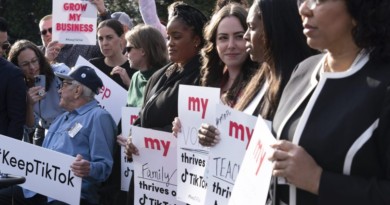Alameda had a $65B line of credit and ‘unlimited withdrawals’
The Sam Bankman-Fried trial gained steam after a somewhat sleepier first half of the day. That’s when prosecutors and the defense asked a witness and former FTX developer about the technical details of the crypto exchange as well as Alameda Research.
But that changed around 4 p.m. when FTX co-founder and CTO Gary Wang took the stand, wearing a wrinkled suit. Prior to Wang taking the stand, there was a 15-minute break during which Bankman-Fried looked visibly irritated.
Bankman-Fried’s parents were also there. During the break, they went to their son seemingly in an effort to provide support. At one point his father, Joseph Bankman, patted his mother, Barbara Fried, on the back, said something and laughed. She didn’t laugh back but continued to look away toward her son.
On the stand, Wang admitted that he committed wire fraud, securities fraud and commodities fraud. He added that Bankman-Fried, Nishad Singh and Caroline Ellison were the individuals he committed the crimes with.
Wang, Singh and Ellison pleaded guilty in late December 2022 as part of a deal to cooperate with the government and testify during this trial.
Wang said that they were given “special privileges from Alameda Research,” the crypto trading firm that he said he and Bankman-Fried started prior to launching FTX. Those privileges included getting large lines of credit, unlimited withdrawals and being able to have negative balances. Wang said that the “unlimited funds” came from FTX customers; a special code was added to customer transactions that funneled the money to Alameda.
He shared during his testimony that he was in charge of writing and reviewing code. And while Bankman-Fried did not write the code, Wang said Bankman-Fried did tell him and other developers what to implement. “Sometimes we talked [disagreements] out, but in the end, it’s Sam’s decision,” Wang said.
Negative balances, unlimited withdrawals
Because of these special privileges, Alameda had a $65 billion line of credit, Wang said. “Normal large businesses have single to double digits [of credit] in the millions.” By the time the two businesses filed for bankruptcy in mid November 2022, Alameda withdrew $8 billion, Wang said.
These internal financial advantages were not disclosed to the public, he shared.
Alameda and FTX were both started by Bankman-Fried and Wang, with ownership split 90% and 10%, and then 17% equity and 65% equity, respectively. Singh also had 5% equity of FTX, and a number of outside investors held other positions, Wang noted.
The ownership percentages never changed, he added. At the time, both Wang and Bankman-Fried were billionaires.
During his time at the companies, Wang also disclosed that Alameda “loaned” him around $200 million to $300 million. But the money never went to his bank account, and it instead went to investments that FTX made into other companies.
Naming the business
The company also picked its name to outsmart other businesses, which might have negative connotations toward companies with crypto jargon in their titles. “Alameda” derived from Alameda County in California and “Research,” was because it “sounds prestigious” and is not using a crypto-related name, Wang said.
The initial funds for Alameda came from Bankman-Fried personally as well as various lenders. Wang said Bankman-Fried also believed it would be easier to get bank accounts, rental leases, investors and so on, with a more “normal” company name.
The prosecutors aired a clip of Bankman-Fried from April 2021 on a podcast, where he explained Alameda’s name. “If we named our company Shitcoin Day Trader’s Inc., no one would do business [with us],” he said at the time.
Wang’s testimony is expected to continue on Friday morning until midday, according to prosecutors at the trial.

